What's in the Pasture?
/The pasture is not a lawn. It is not a monoculture. My brother says it is more of a salad bar for sheep. Unless you walk around out there you don't realize the number of plants that grow there. I am embarrassed that after 16 years of living here I don't know the names of all of them. I have decided to change that. I am going to combine my enjoyment of photography and my recently dredged up college hobby (and class projects) of pressing plants and create a personalized herbarium of sorts. These photos are a start.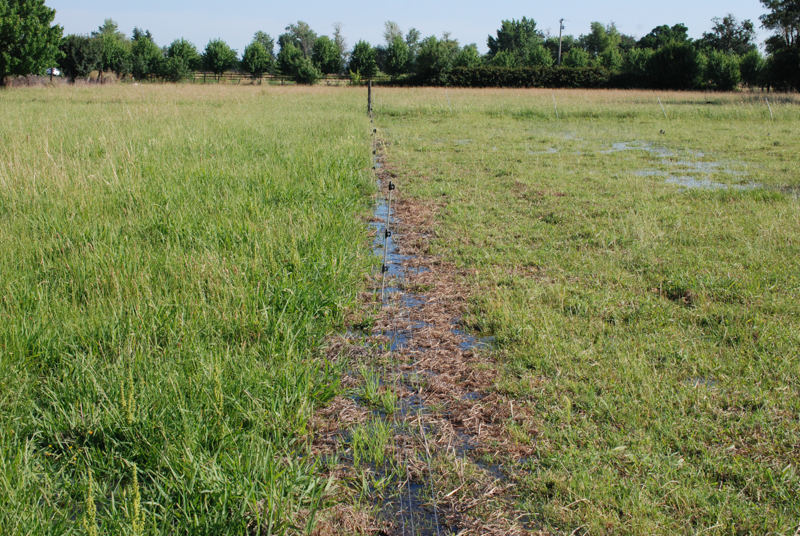 I irrigated this weekend. The sheep were just moved off the paddock to the right and when it dries up enough they will go on the one to the left. Can you see the difference? It took only two days for them to eat that feed.
I irrigated this weekend. The sheep were just moved off the paddock to the right and when it dries up enough they will go on the one to the left. Can you see the difference? It took only two days for them to eat that feed.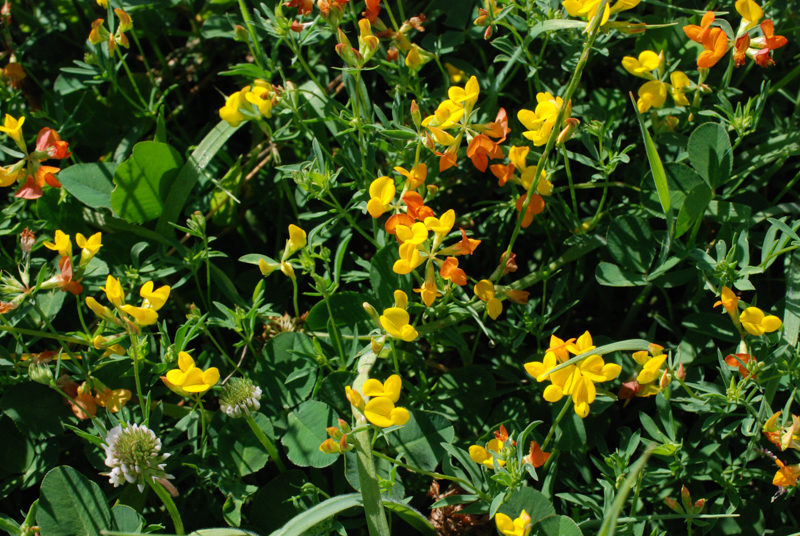 One of their favorite plants is Birdsfoot Trefoil. It is a legume which means it is one of the plants that converts nitrogen in the air to a form that can be used by the plant. It is actually not the plant that does that but the bacteria that live in nodules on the roots of legumes.
One of their favorite plants is Birdsfoot Trefoil. It is a legume which means it is one of the plants that converts nitrogen in the air to a form that can be used by the plant. It is actually not the plant that does that but the bacteria that live in nodules on the roots of legumes.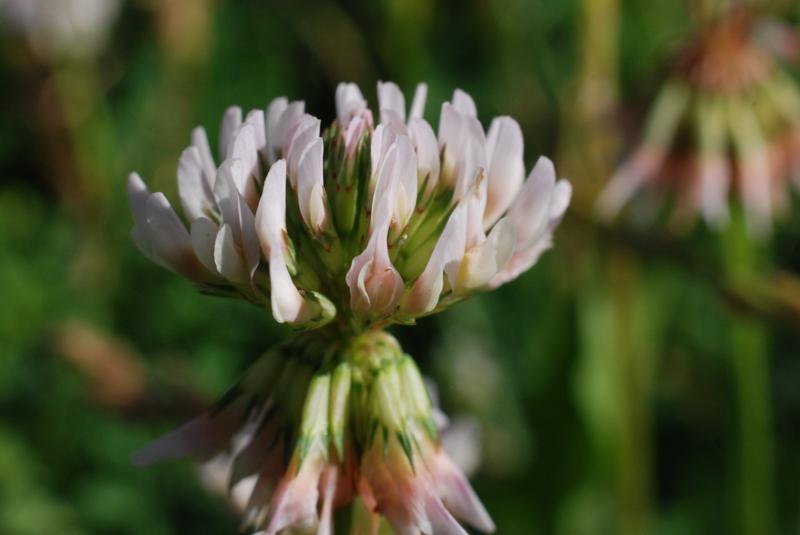 Clovers are also legumes. This is a variety of white clover.
Clovers are also legumes. This is a variety of white clover.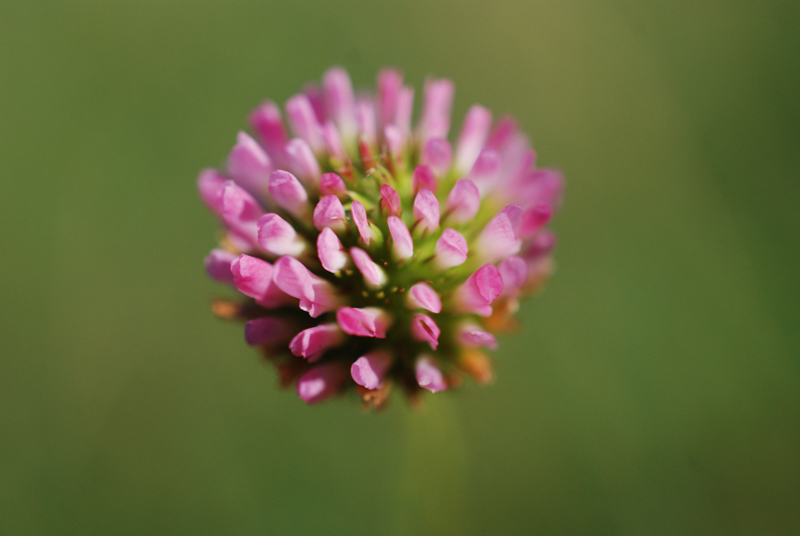 This morning I noticed just a few of these flowers. I can't decide if this is a variant of the white clover or is a different species. The leaves are similar. I'll have to do some more checking.
This morning I noticed just a few of these flowers. I can't decide if this is a variant of the white clover or is a different species. The leaves are similar. I'll have to do some more checking. Do you see how most of the other plants have been eaten and this one has not been touched? The sheep avoid plants that are toxic to them. This is Narrow-leaved Milkweed (Asclepias fascicularis). Not only is it a favored species for the monarch butterfly but according to a Plant Guide published by the NRCS "Zuni people utilize the silky seed fibers, which are spun on a hand-held wooden spindle, made into yarn, and woven into fabric (especially for dancers)...Milkweeds supply tough fibers for making cords and ropes, and for weaving a coarse cloth. Milkweeds stems are collected after the stalks dry in late fall to early winter. The dried stalks are split open to release the fibers. Milkweed fibers are sometimes mixed with fibers of Indian hemp, Apocynum cannabinum." Sounds like a good challenge to my fiber-loving friends.
Do you see how most of the other plants have been eaten and this one has not been touched? The sheep avoid plants that are toxic to them. This is Narrow-leaved Milkweed (Asclepias fascicularis). Not only is it a favored species for the monarch butterfly but according to a Plant Guide published by the NRCS "Zuni people utilize the silky seed fibers, which are spun on a hand-held wooden spindle, made into yarn, and woven into fabric (especially for dancers)...Milkweeds supply tough fibers for making cords and ropes, and for weaving a coarse cloth. Milkweeds stems are collected after the stalks dry in late fall to early winter. The dried stalks are split open to release the fibers. Milkweed fibers are sometimes mixed with fibers of Indian hemp, Apocynum cannabinum." Sounds like a good challenge to my fiber-loving friends. These are Narrow-leaved Milkweed flowers in various stages...
These are Narrow-leaved Milkweed flowers in various stages...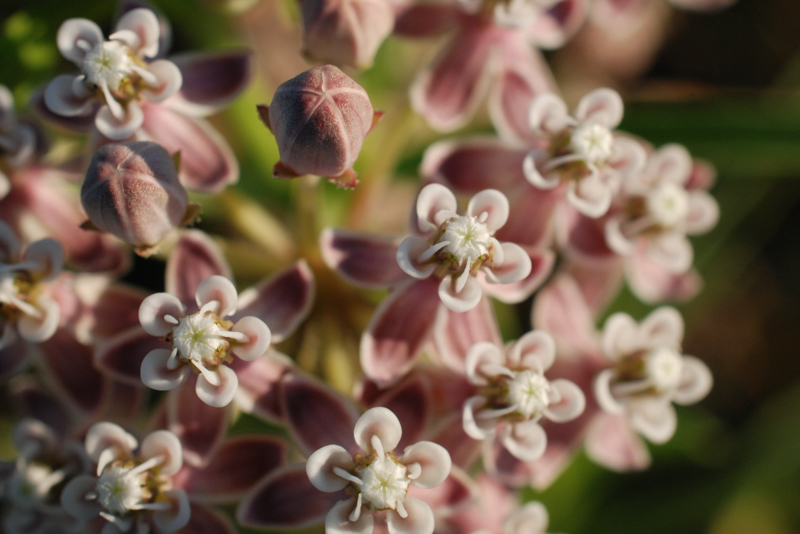 ...and a close-up.
...and a close-up.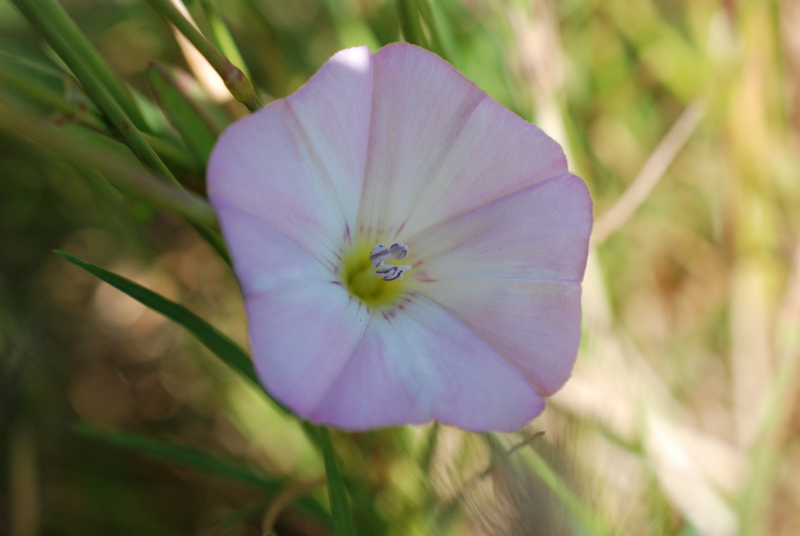 Field bindweed (Convolvulaceae arvensis), also known as morning glory. It is, according to a U.C. IPM website, "a perennial broadleaf, is considered one of the most problematic weeds in agricultural fields throughout temperate regions worldwide".
Field bindweed (Convolvulaceae arvensis), also known as morning glory. It is, according to a U.C. IPM website, "a perennial broadleaf, is considered one of the most problematic weeds in agricultural fields throughout temperate regions worldwide".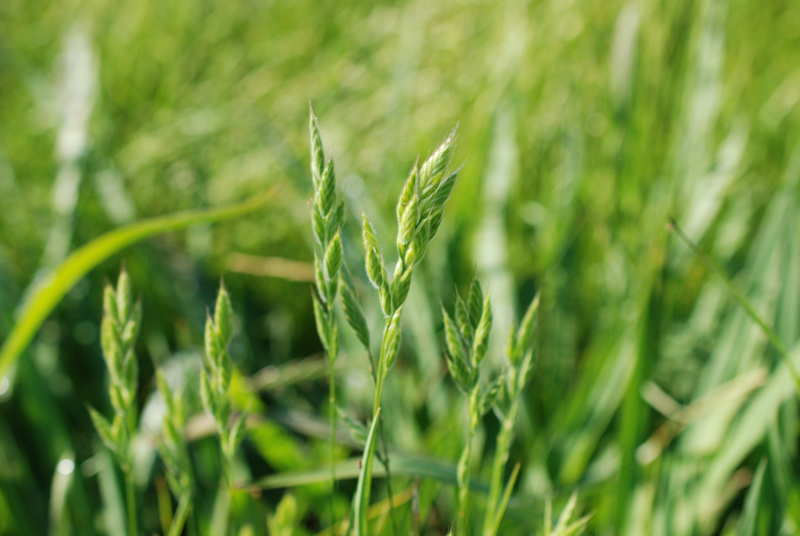 Soft Chess or Soft Brome, a non-native annual grass.
Soft Chess or Soft Brome, a non-native annual grass.
Hare Barley. Also from the U.C. IPM site, "It is a useful livestock forage early in the season before the flower spikes develop. However, at maturity the spikelets have stiff, barbed, needle-like awns, and sharp bases that can injure the mouth, eyes, nasal passages, ears, and skin of animals." Those are one of the many grass seeds we call foxtails and spend a fortune getting out of dogs ears and noses and agonize over when we find an otherwise beautiful fleece full of them.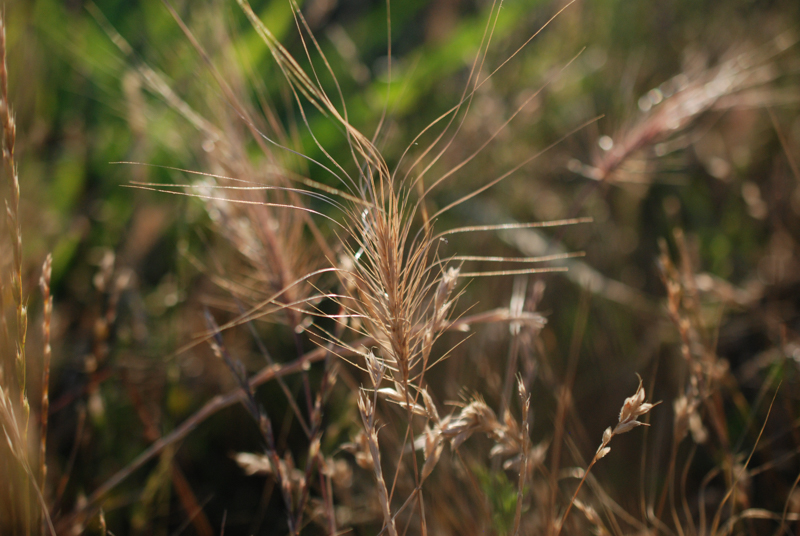 Medusahead as it is drying out. Medusahead covers thousands of acres of California foothills. It is not normally found in irrigated pasture, but it is in the easternmost paddock here which sometimes does not irrigate well. I have reclaimed part of that paddock, but I continually fight this plant. I find patches of it in other areas of the pasture and, although this is not an effective control technique, I pull it up by the handfuls as I walk by, coming back to the barn with it stuffed in the pockets of my overalls. It is a nasty plant that is "...among the worst weeds: not only does medusahead compete for resources with more desirable species, but it changes ecosystem function to favor its own survival at the expense of the entire ecosystem...Because grazing animals selectively avoid this plant, and because medusahead thatch tends to suppress desirable forage species, infestations often develop into near-monotypic stands." From the U.C. Davis Medusahead Management Guide.
Medusahead as it is drying out. Medusahead covers thousands of acres of California foothills. It is not normally found in irrigated pasture, but it is in the easternmost paddock here which sometimes does not irrigate well. I have reclaimed part of that paddock, but I continually fight this plant. I find patches of it in other areas of the pasture and, although this is not an effective control technique, I pull it up by the handfuls as I walk by, coming back to the barn with it stuffed in the pockets of my overalls. It is a nasty plant that is "...among the worst weeds: not only does medusahead compete for resources with more desirable species, but it changes ecosystem function to favor its own survival at the expense of the entire ecosystem...Because grazing animals selectively avoid this plant, and because medusahead thatch tends to suppress desirable forage species, infestations often develop into near-monotypic stands." From the U.C. Davis Medusahead Management Guide.
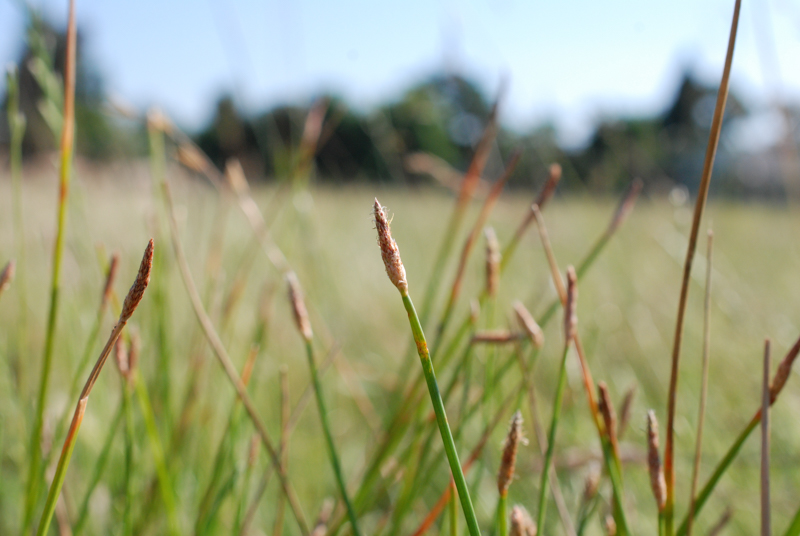 I have ID'd this one as Blunt Spikerush (Eleocharis obtusa), not a grass, but a sedge that is found on poorly drained soil and marshy areas. That's my pasture...poorly drained soil. There is a lot of this sedge in the middle and south end of three or four of the paddocks. It looks like foot-tall grass, but that is why it is important to actually look at what is out there. This does not make good forage.
I have ID'd this one as Blunt Spikerush (Eleocharis obtusa), not a grass, but a sedge that is found on poorly drained soil and marshy areas. That's my pasture...poorly drained soil. There is a lot of this sedge in the middle and south end of three or four of the paddocks. It looks like foot-tall grass, but that is why it is important to actually look at what is out there. This does not make good forage.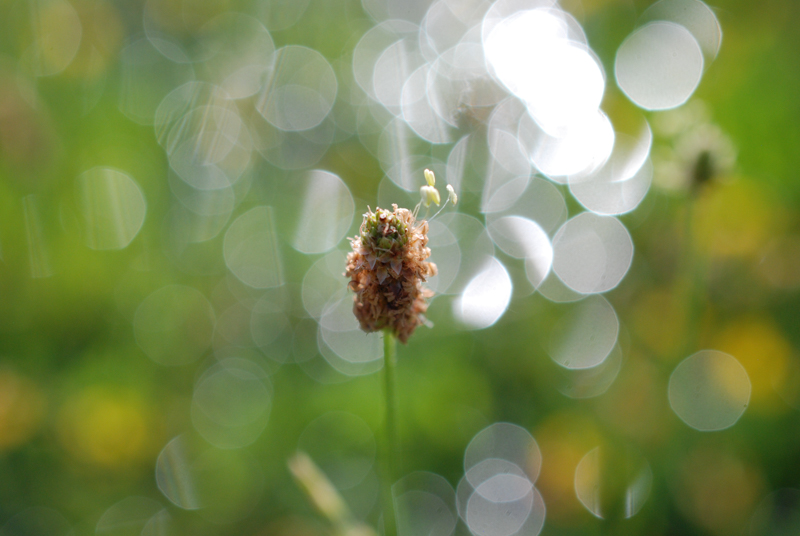 A rather artsy shot of Buckhorn Plantain, found throughout California...
A rather artsy shot of Buckhorn Plantain, found throughout California...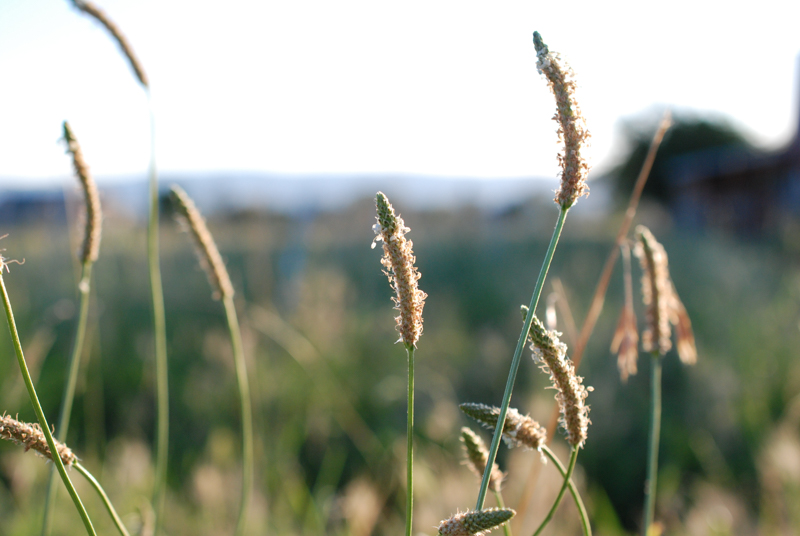 ...and a photo in which you will probably more easily recognize it.
...and a photo in which you will probably more easily recognize it.
Well, that's nine species of plants in the pasture. There are dozens more to go.

 This is the ditch that runs north-south and brings the water from the upper ditch to the one that goes from west to east along the bigger pasture.
This is the ditch that runs north-south and brings the water from the upper ditch to the one that goes from west to east along the bigger pasture.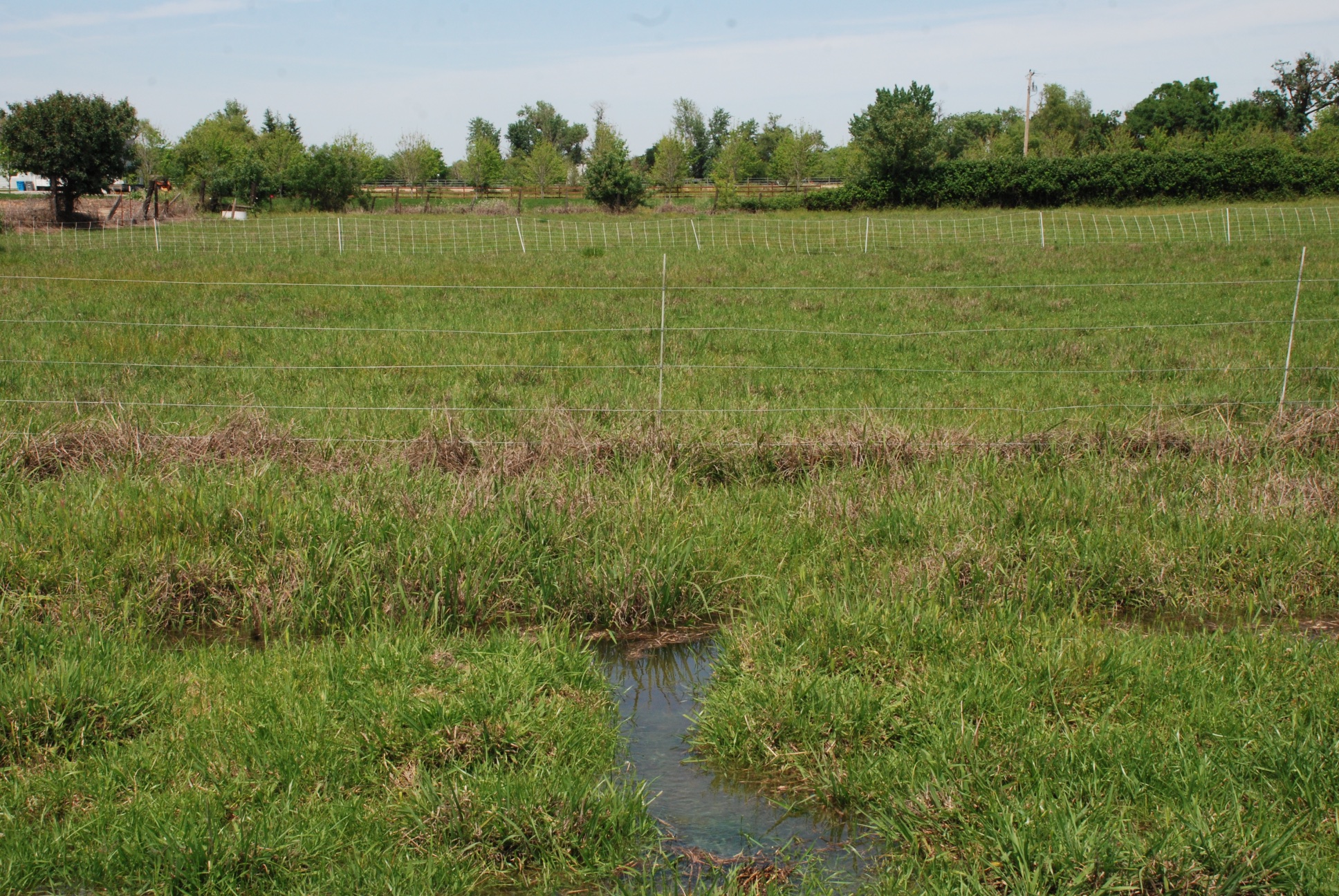 This photo is looking the same direction but from a little bit west of the first one. You can see the same row of overgrown blackberries along the fence. The standpipe where the water comes in is in the upper left corner. In the lower center of the photo is one of the cut-outs that lets the water flow from the ditch into the field.
This photo is looking the same direction but from a little bit west of the first one. You can see the same row of overgrown blackberries along the fence. The standpipe where the water comes in is in the upper left corner. In the lower center of the photo is one of the cut-outs that lets the water flow from the ditch into the field.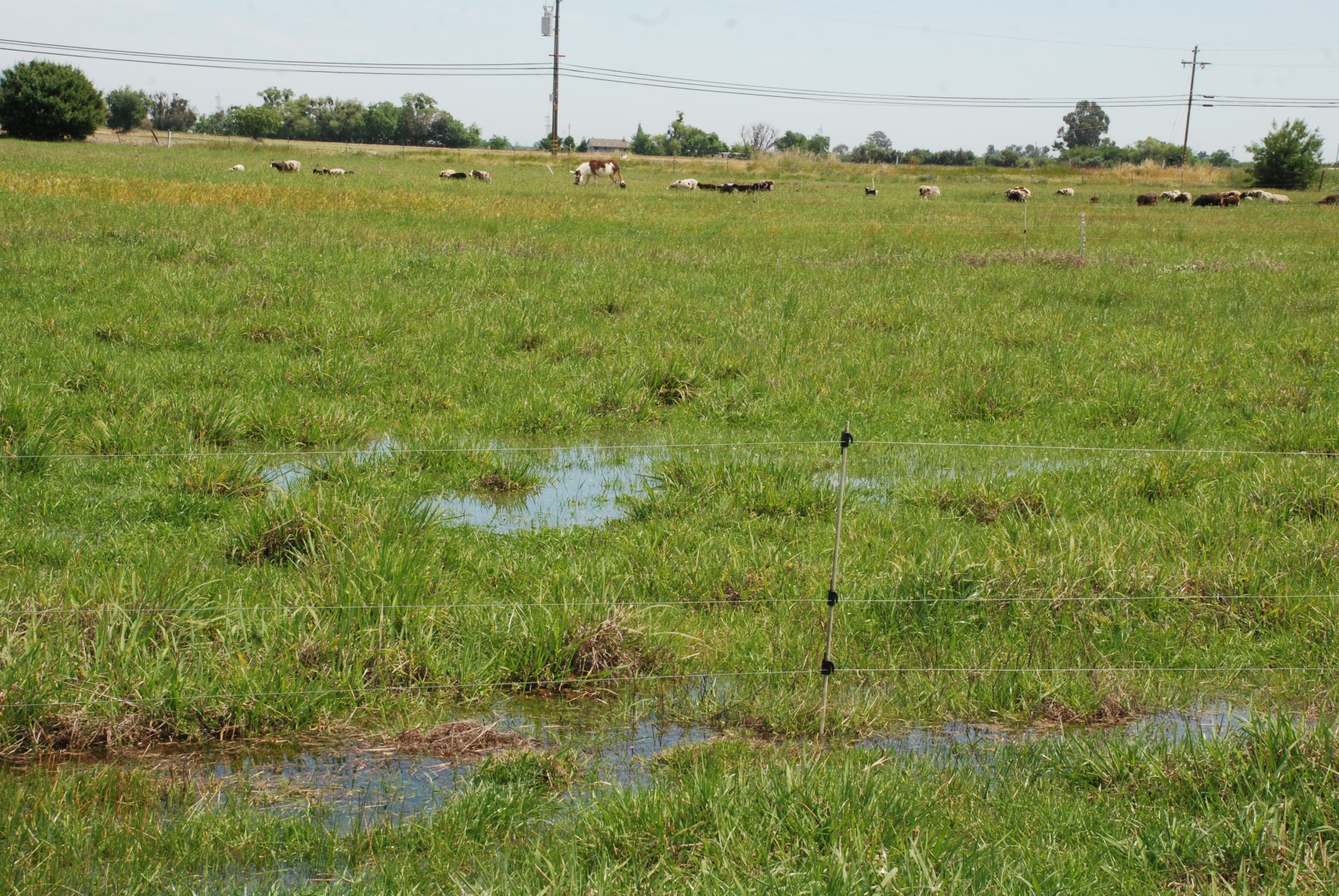 Looking to the east as the water is flooding the pasture from north to south. In this photo the water hasn't gotten very far into the paddock where the sheep are.
Looking to the east as the water is flooding the pasture from north to south. In this photo the water hasn't gotten very far into the paddock where the sheep are.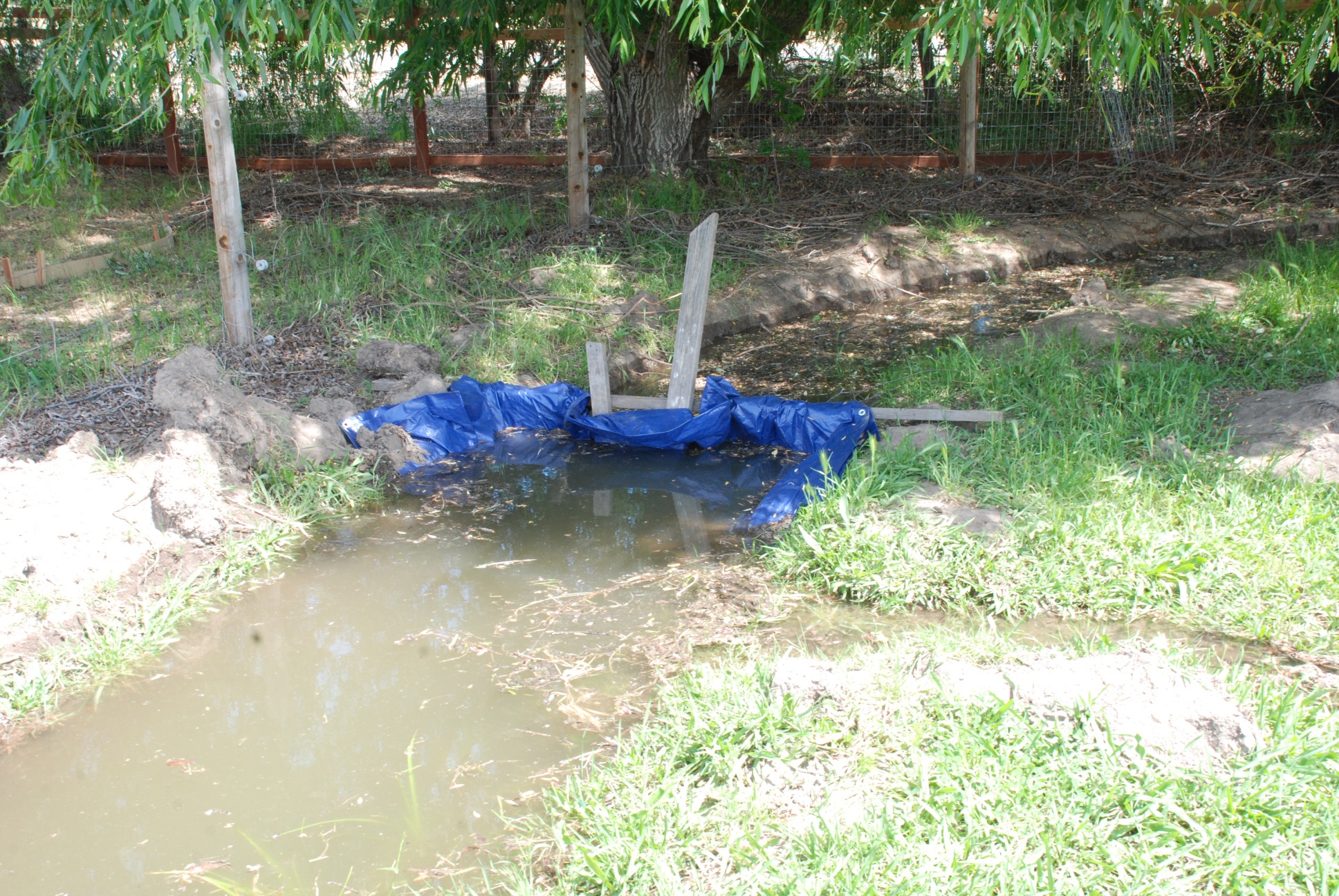 Here is that tarp I showed in the last post.
Here is that tarp I showed in the last post.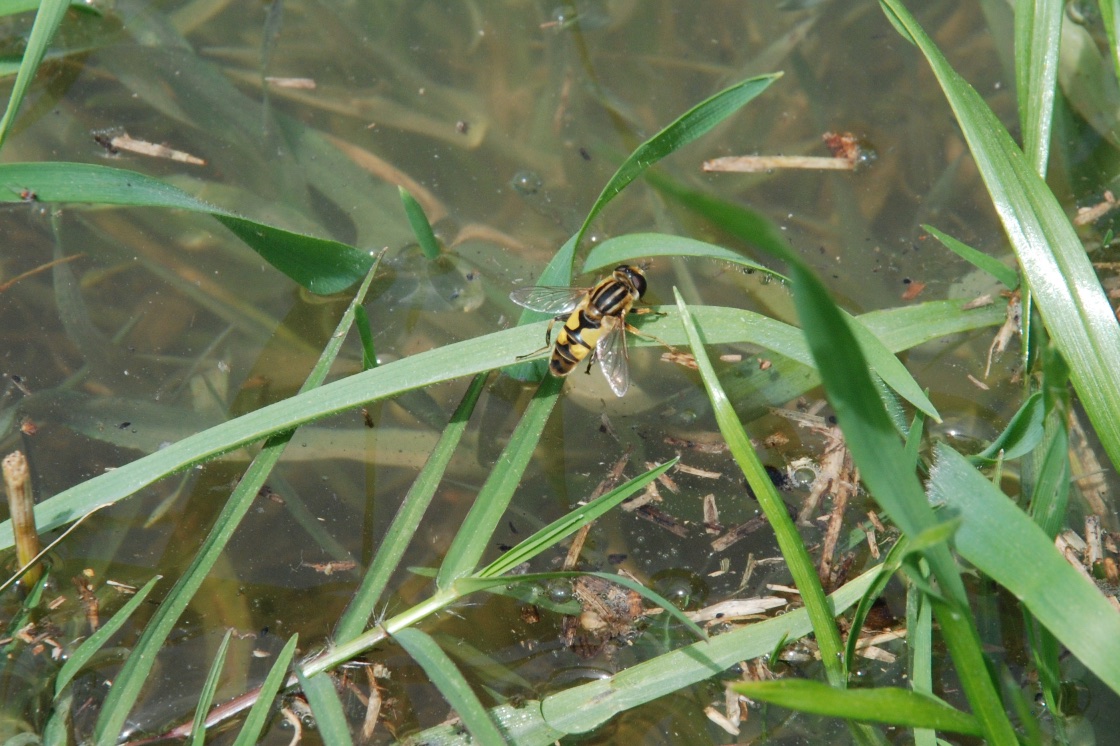 There are things to see besides just water and grass. One of the first things I noticed after the water filled the ditch was buzzing. These insects were everywhere over the water. I tried to ID it on the internet but didn't find it. Anyone know what this is?
There are things to see besides just water and grass. One of the first things I noticed after the water filled the ditch was buzzing. These insects were everywhere over the water. I tried to ID it on the internet but didn't find it. Anyone know what this is? 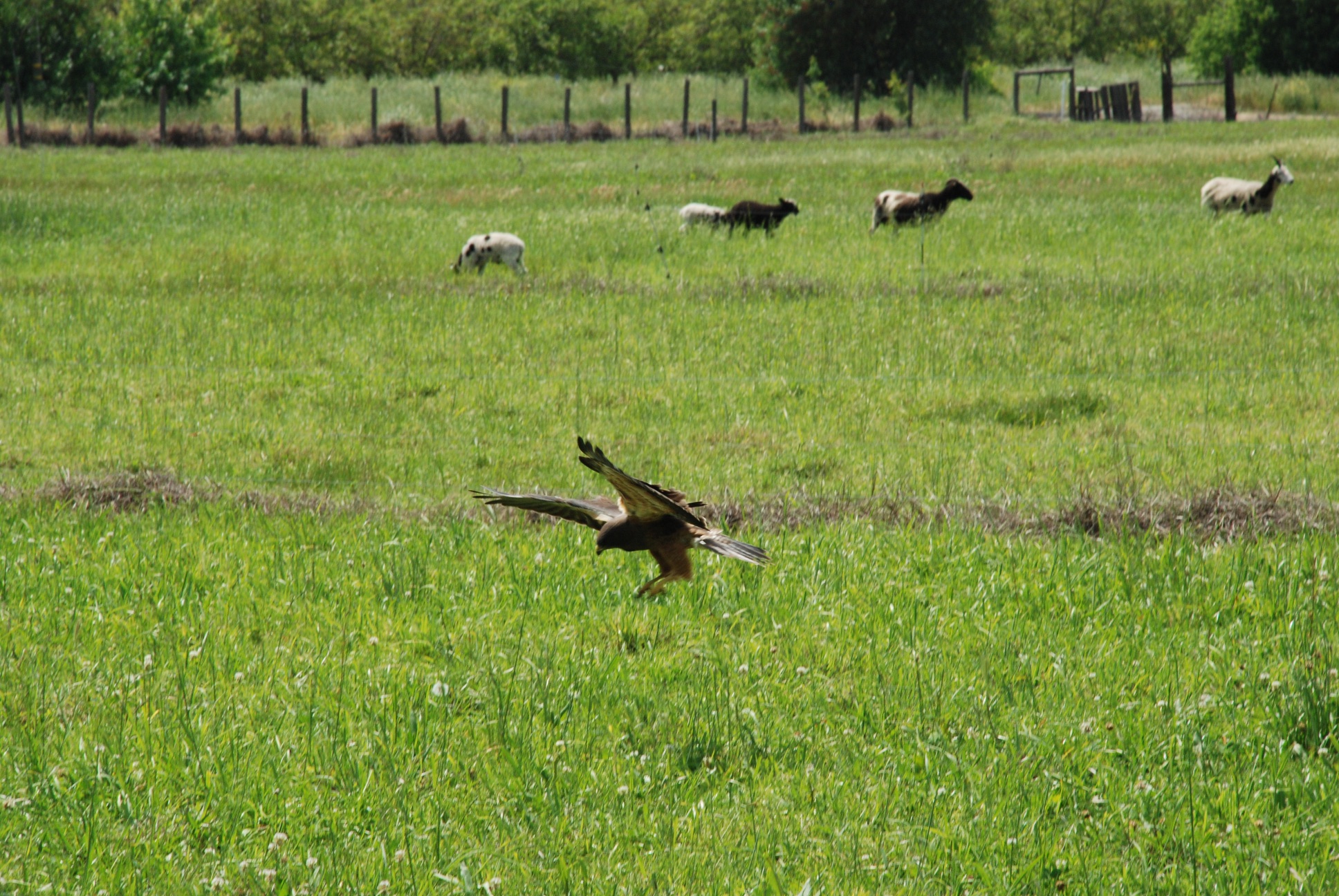 This is one of the pair of Swainson's hawks that lives nearby and hunts in our pasture.
This is one of the pair of Swainson's hawks that lives nearby and hunts in our pasture.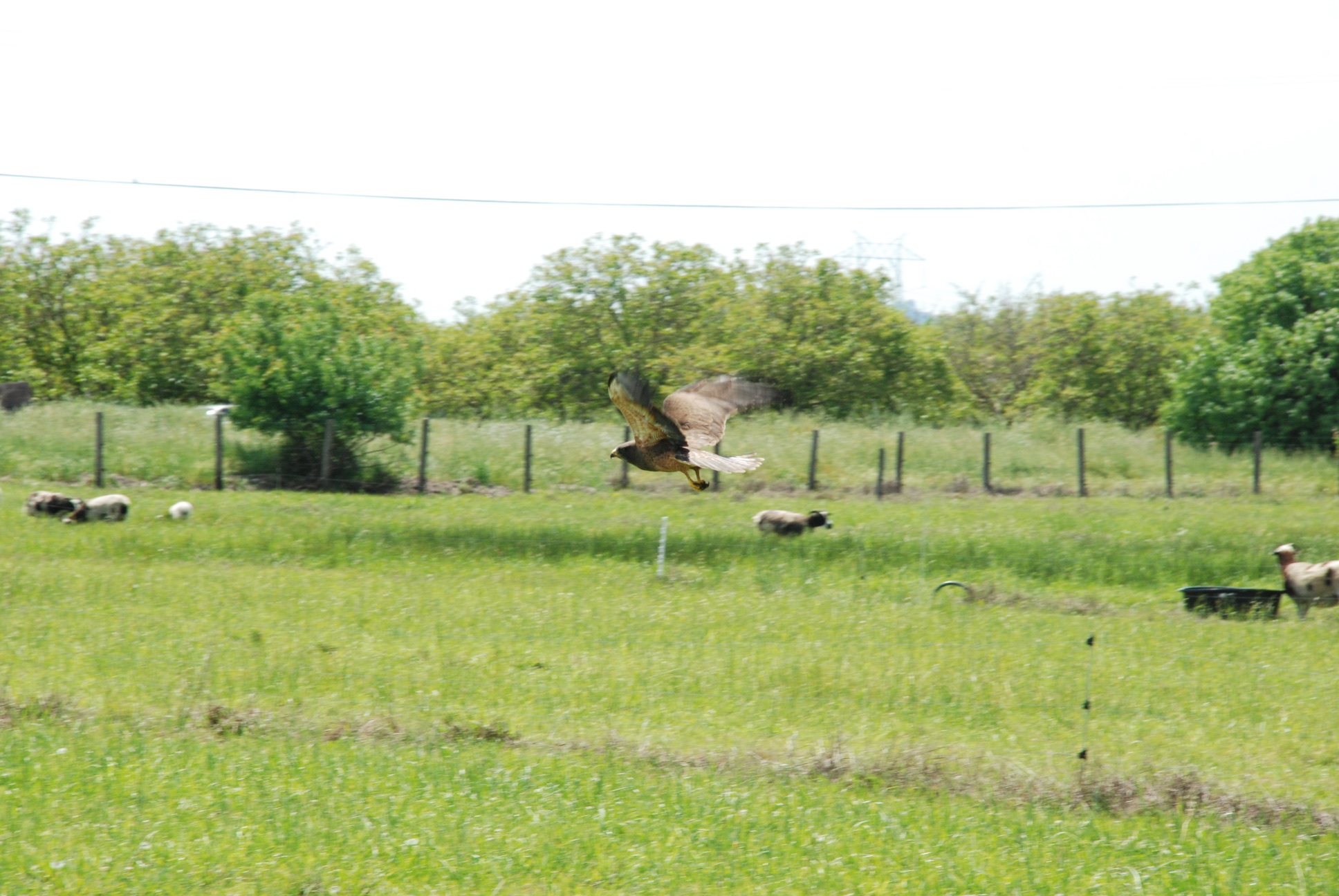 We have enough gophers to feed an army of hawks.
We have enough gophers to feed an army of hawks.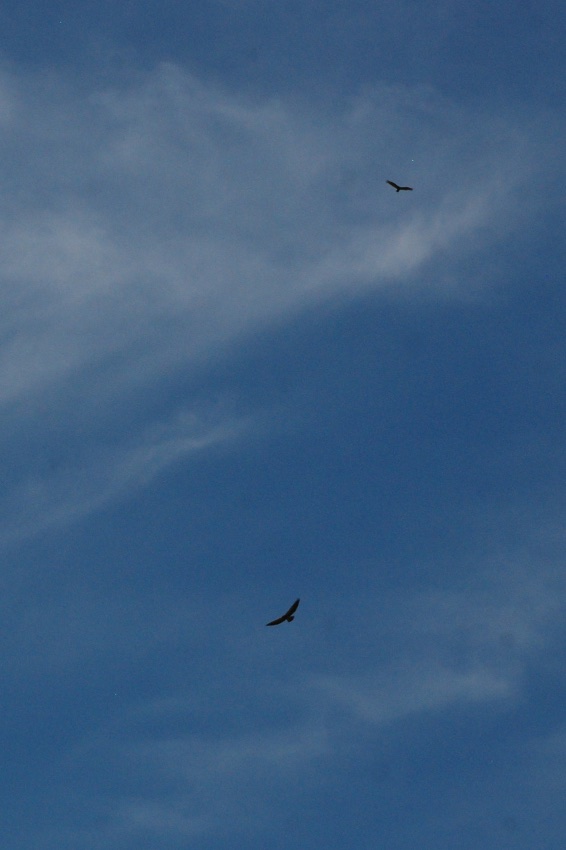 I was hoping to see the hawk catch something but it continued to soar higher and higher. When I saw the buzzard (upper right) it reminded me of watching airplanes that you know are in different flight paths, although they look as though they'll fly right into each other.
I was hoping to see the hawk catch something but it continued to soar higher and higher. When I saw the buzzard (upper right) it reminded me of watching airplanes that you know are in different flight paths, although they look as though they'll fly right into each other.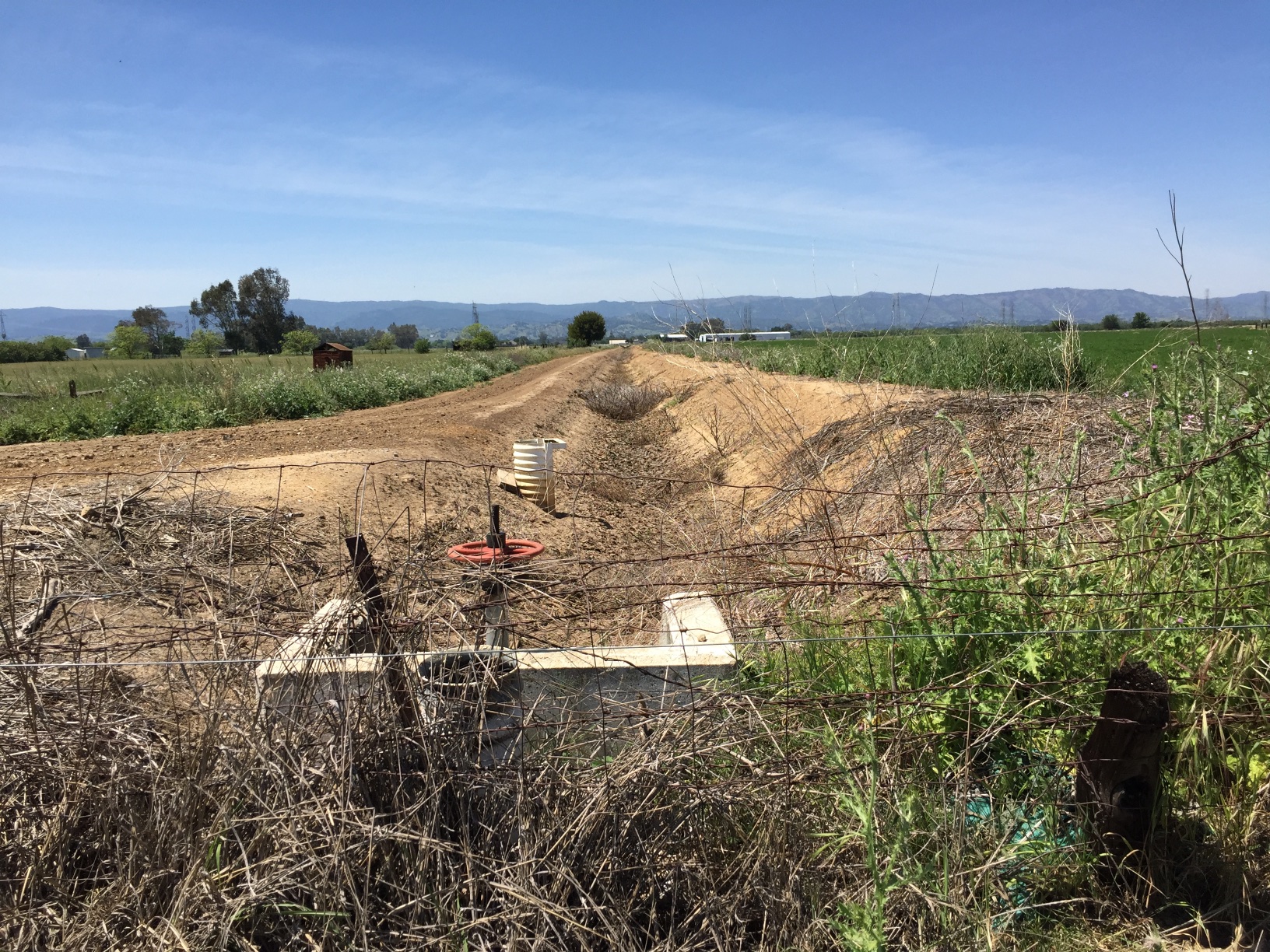 This was taken from standing in the northwest corner of the property and looking west. When SID (Solano Irrigation District) opens the right gate the water comes down that canal, through a gate in the cement structure at the bottom of the photo and...
This was taken from standing in the northwest corner of the property and looking west. When SID (Solano Irrigation District) opens the right gate the water comes down that canal, through a gate in the cement structure at the bottom of the photo and...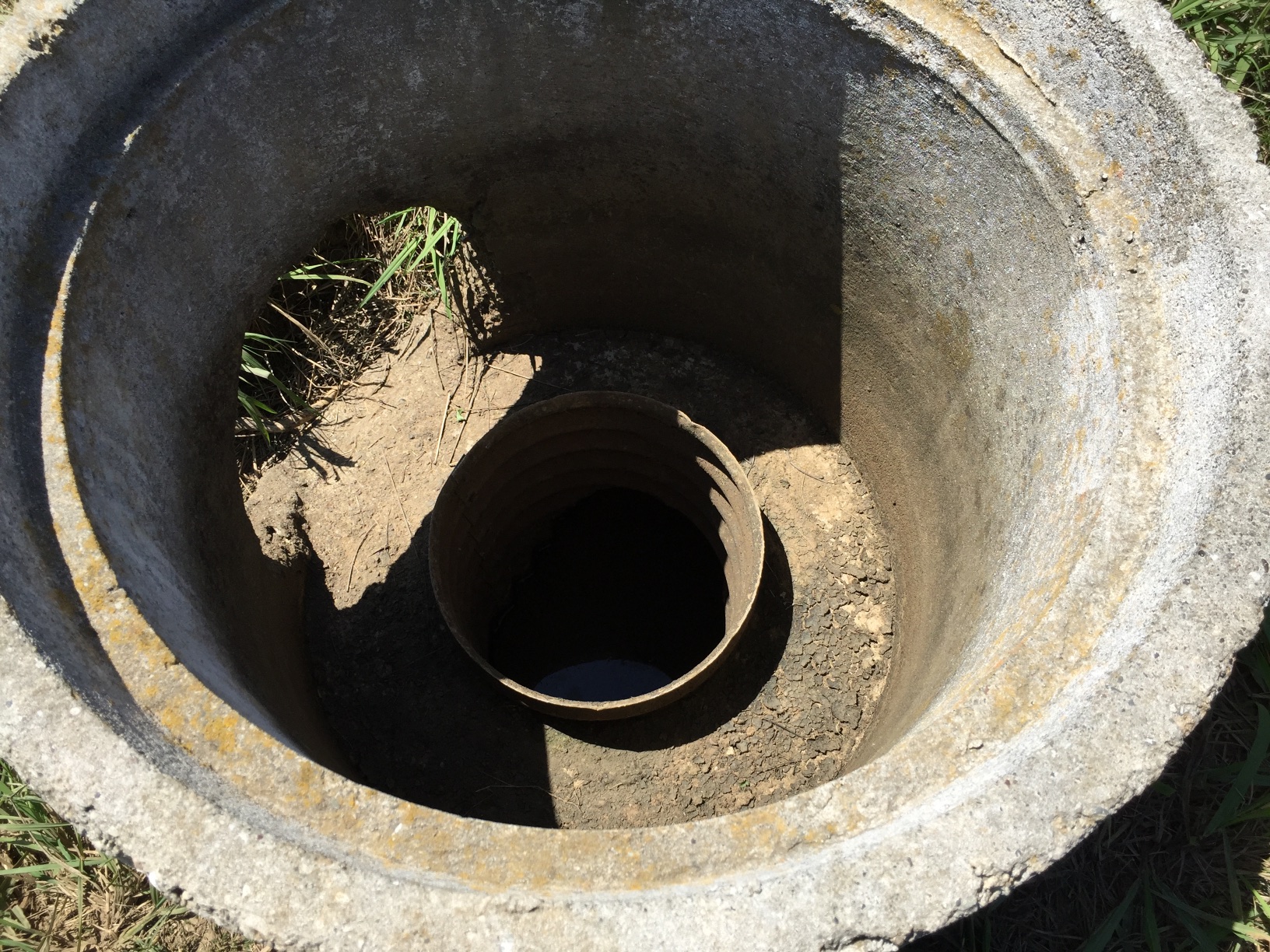 ...comes up through this standpipe. It goes out that hole on the left and...
...comes up through this standpipe. It goes out that hole on the left and...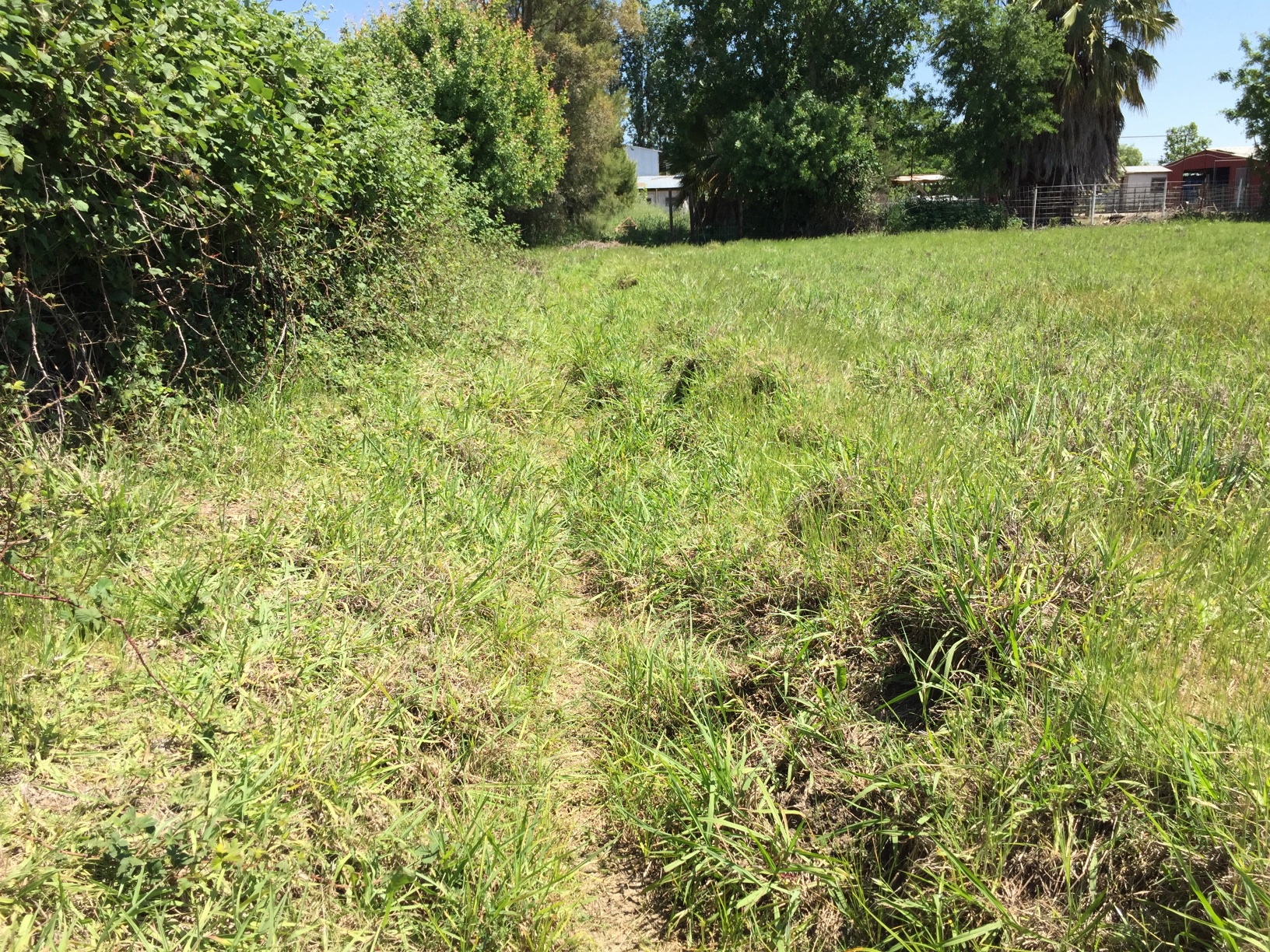 into this ditch. At the end of the ditch it turns south and goes into the other part of the pasture. Later in the year this ditch will require weed-wacking for the whole length to allow the water to flow. This time I didn't need to do that.
into this ditch. At the end of the ditch it turns south and goes into the other part of the pasture. Later in the year this ditch will require weed-wacking for the whole length to allow the water to flow. This time I didn't need to do that.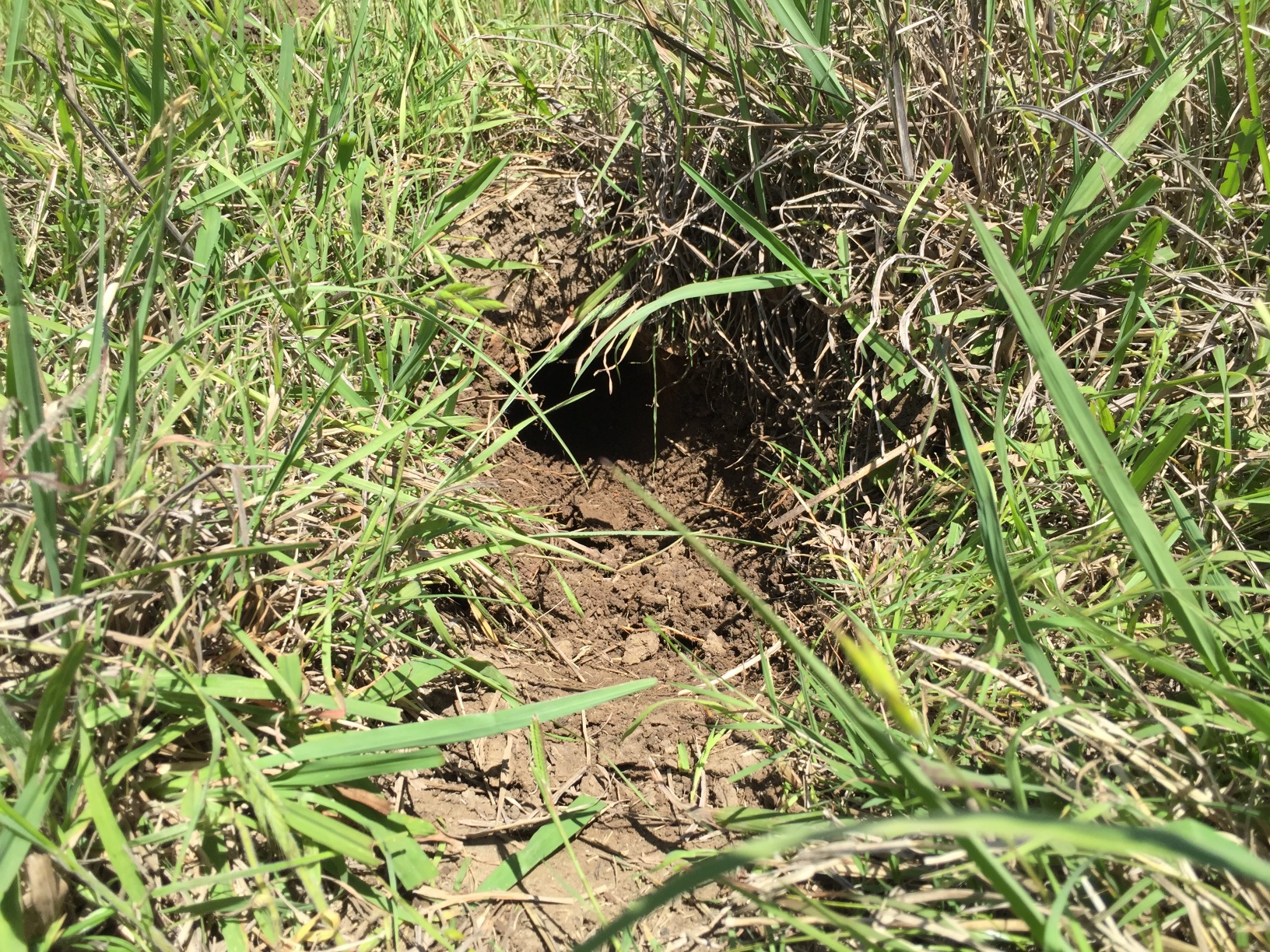 This part of the ditch has old pipes that take the water under the burm. I can find two of the three that used to be functional.
This part of the ditch has old pipes that take the water under the burm. I can find two of the three that used to be functional.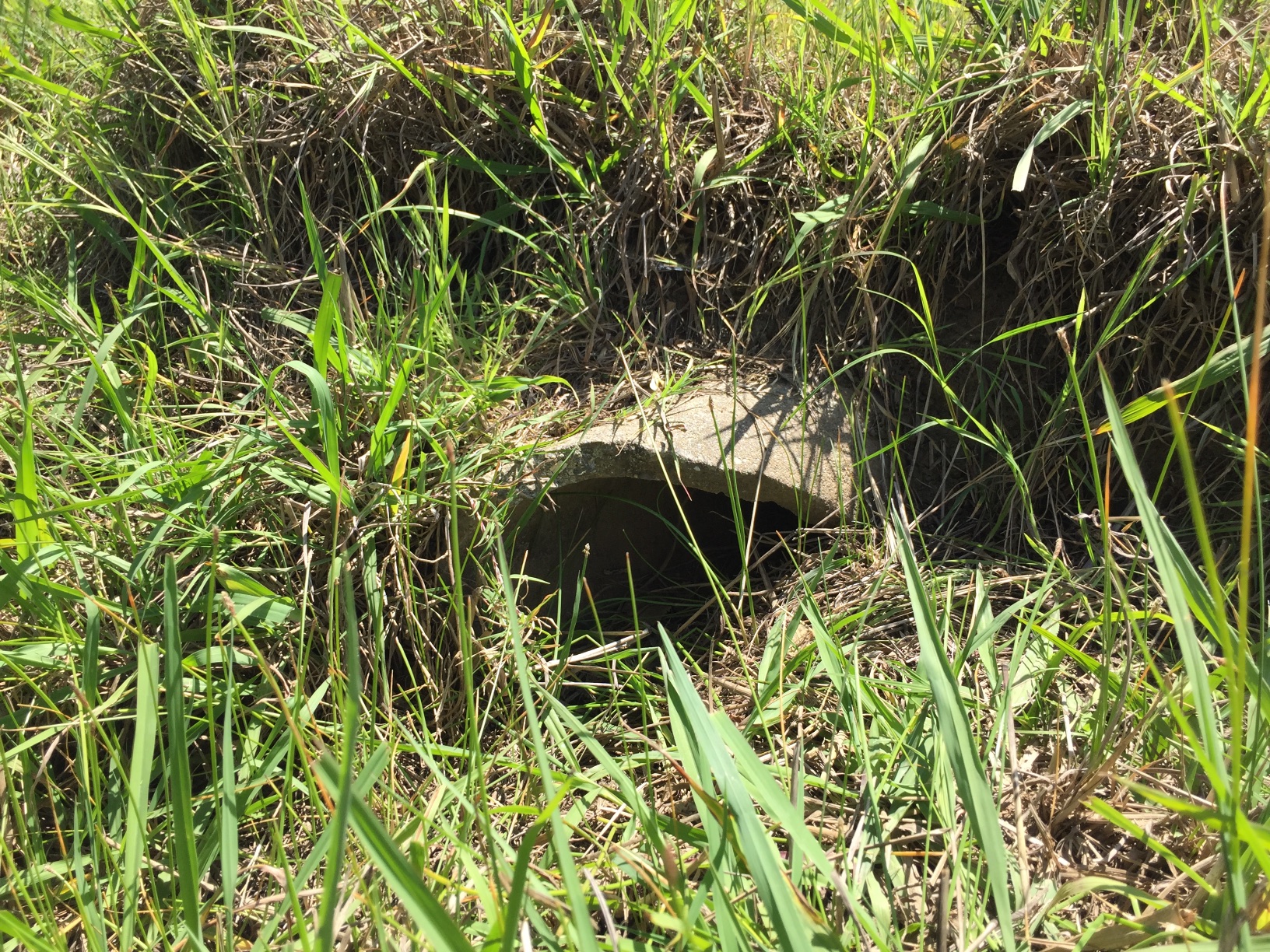 The first job is to dig out around both ends of these.
The first job is to dig out around both ends of these.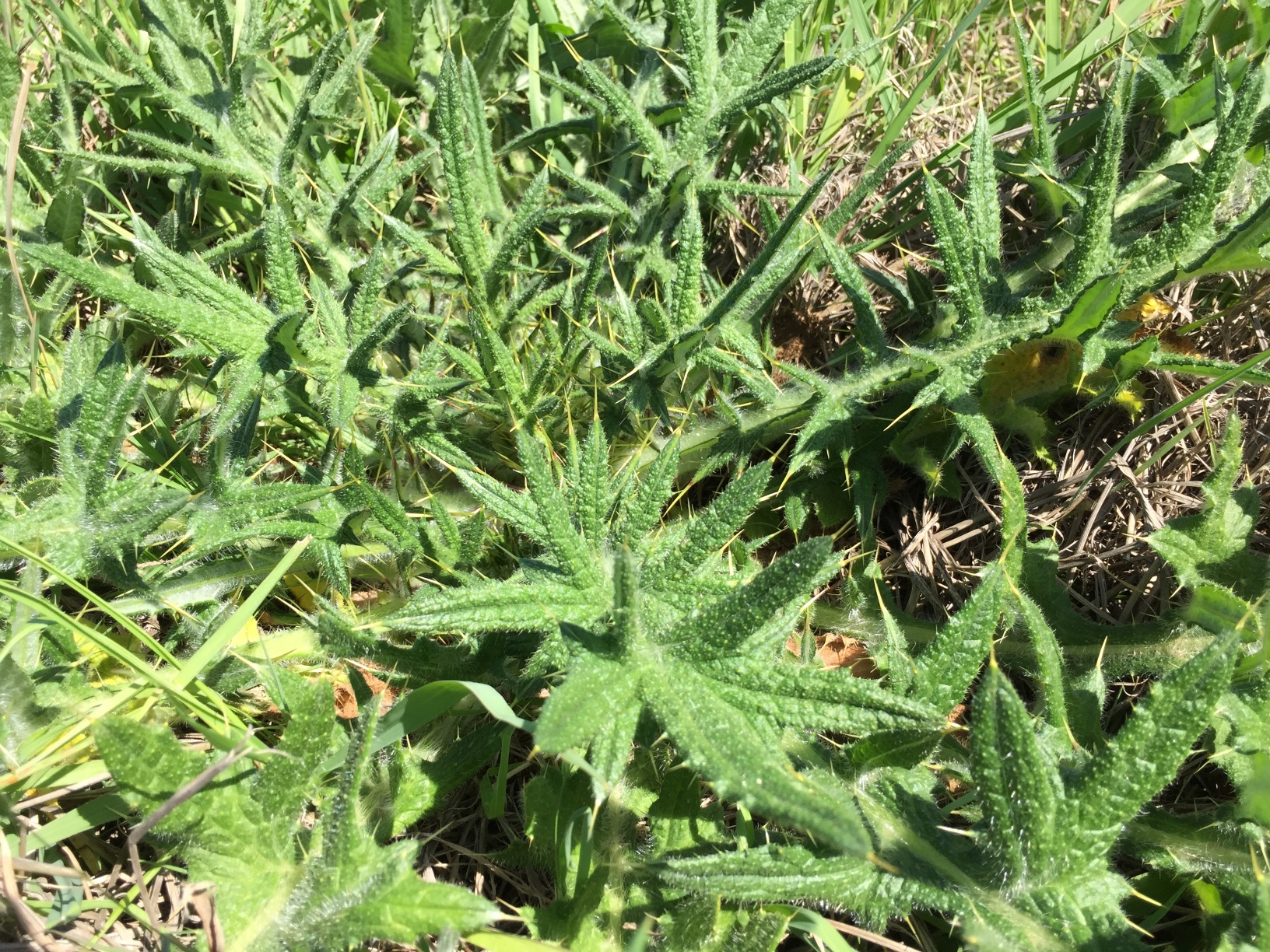 As I walk through the pasture I find thistles that need to be chopped.
As I walk through the pasture I find thistles that need to be chopped.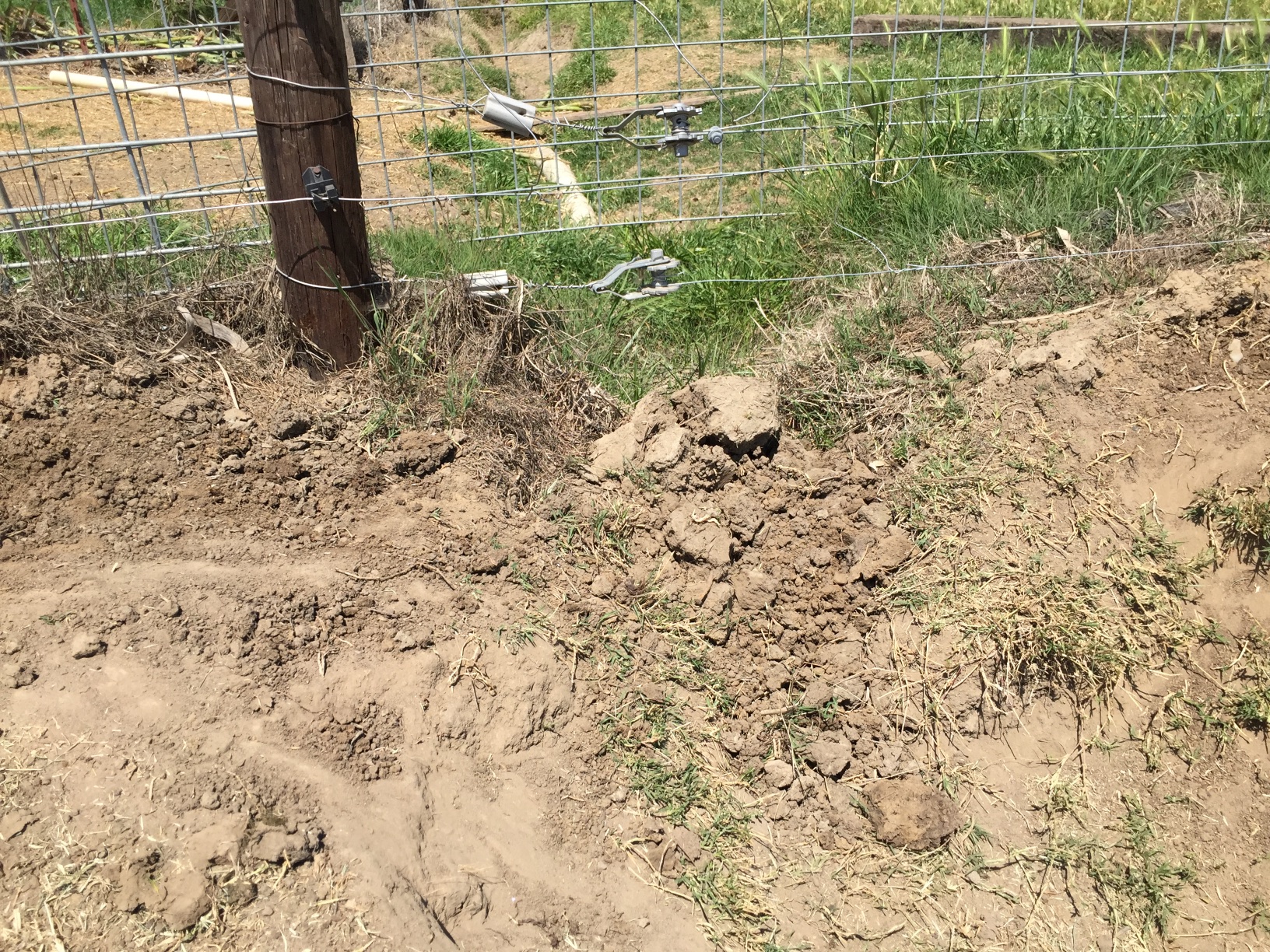 The rest of the pasture doesn't have those pipes, but instead has cut-outs or places where the burm is cut away to allow the water to flow from the ditch into the pasture. I didn't get photos of those. This photo is a cut-out (under the fence) that I had to fill in because it was where we had cut through the burm to allow water flow INTO the ditch in the winter to help drain the rainwater that was all around the barn.
The rest of the pasture doesn't have those pipes, but instead has cut-outs or places where the burm is cut away to allow the water to flow from the ditch into the pasture. I didn't get photos of those. This photo is a cut-out (under the fence) that I had to fill in because it was where we had cut through the burm to allow water flow INTO the ditch in the winter to help drain the rainwater that was all around the barn. 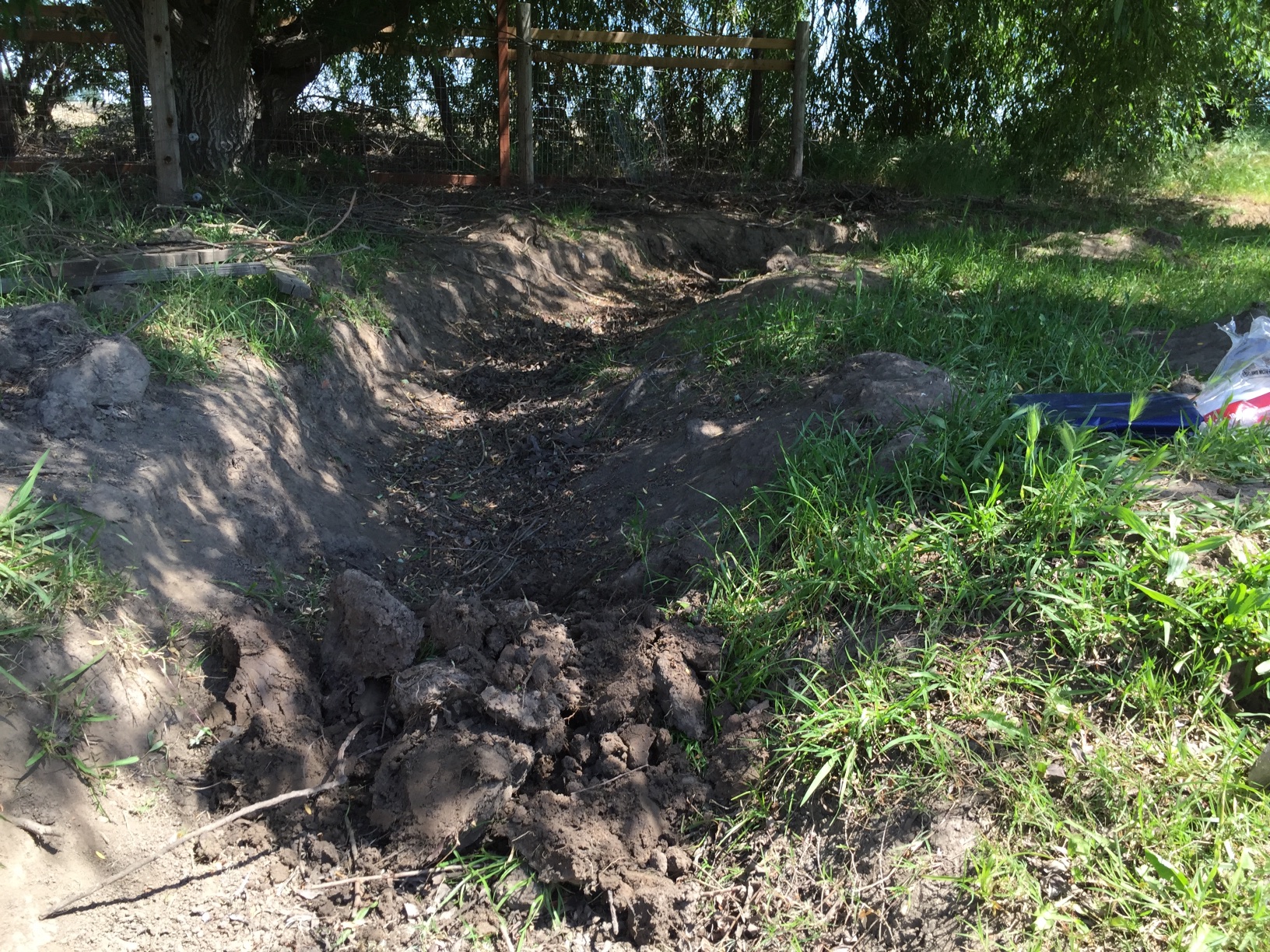 Here is the place at the northeast corner of the pasture where I have to put a tarp to keep the water backed up in the ditch. After this point the ditch turns south and drains at the southeast corner of the property.
Here is the place at the northeast corner of the pasture where I have to put a tarp to keep the water backed up in the ditch. After this point the ditch turns south and drains at the southeast corner of the property.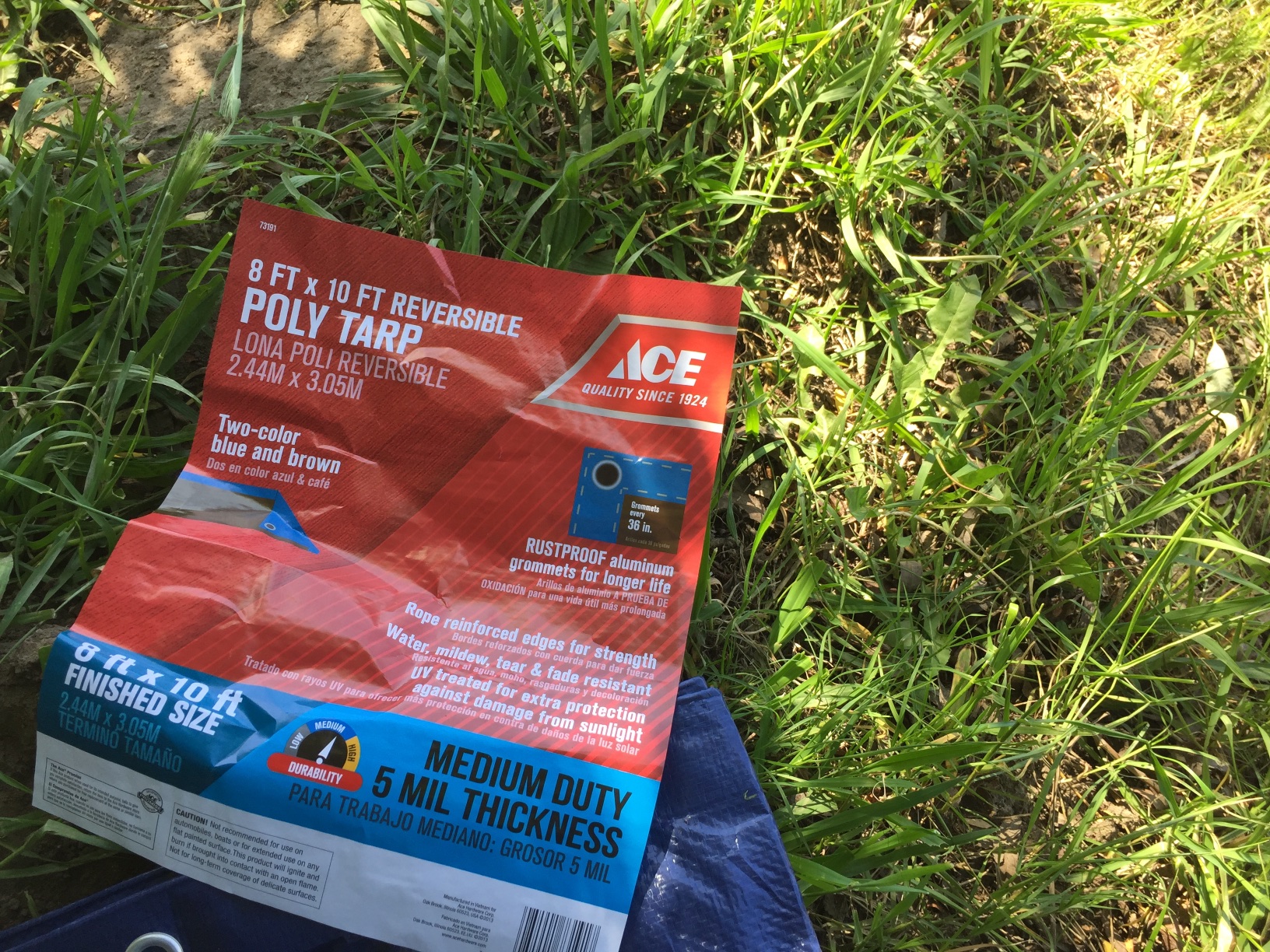 I can never remember what size tarp to get. I bought 2 sizes and took this photo to remind myself that this one is just fine.
I can never remember what size tarp to get. I bought 2 sizes and took this photo to remind myself that this one is just fine.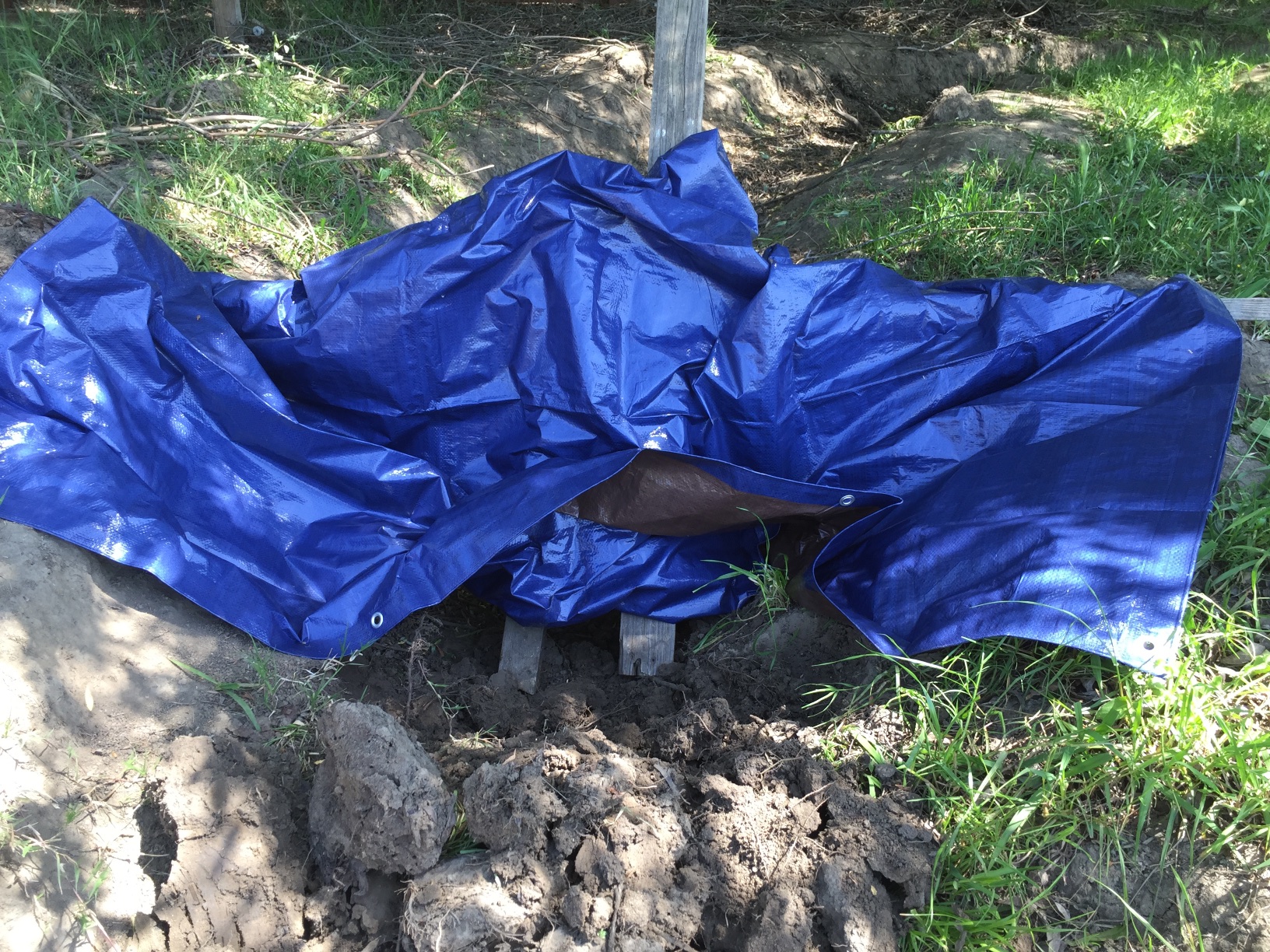 The idea is to set the tarp so that the edges are buried in dirt and those boards behind will keep the water from pushing the tarp down flat. I did this twice.
The idea is to set the tarp so that the edges are buried in dirt and those boards behind will keep the water from pushing the tarp down flat. I did this twice. 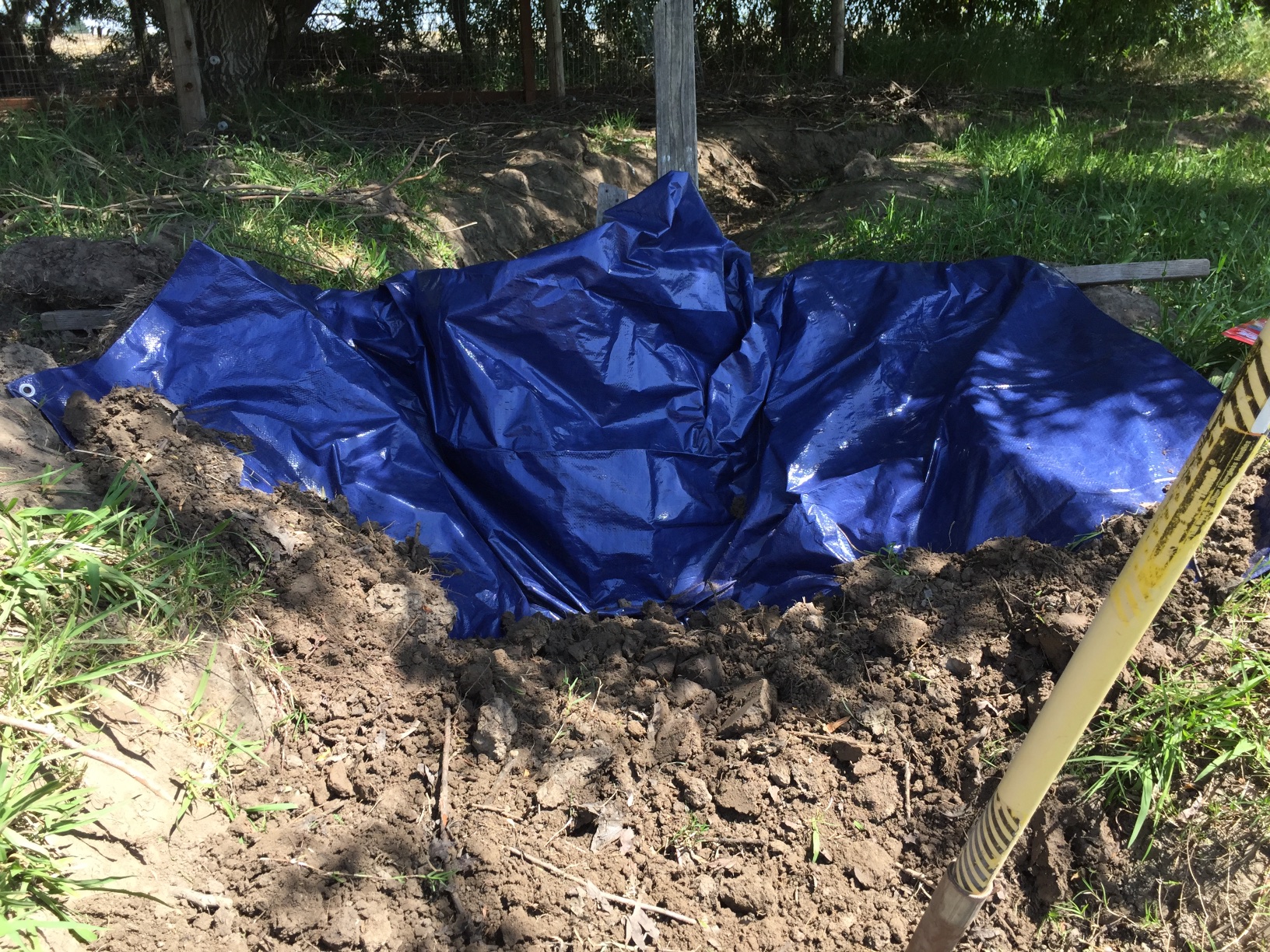 The first time the dirt that holds the tarp down on the bottom was too high. That means when I released the tarp at the end of irrigating there would still be a dam. I have a hard enough time getting the ditch to empty that I don't need to impede it more.
The first time the dirt that holds the tarp down on the bottom was too high. That means when I released the tarp at the end of irrigating there would still be a dam. I have a hard enough time getting the ditch to empty that I don't need to impede it more.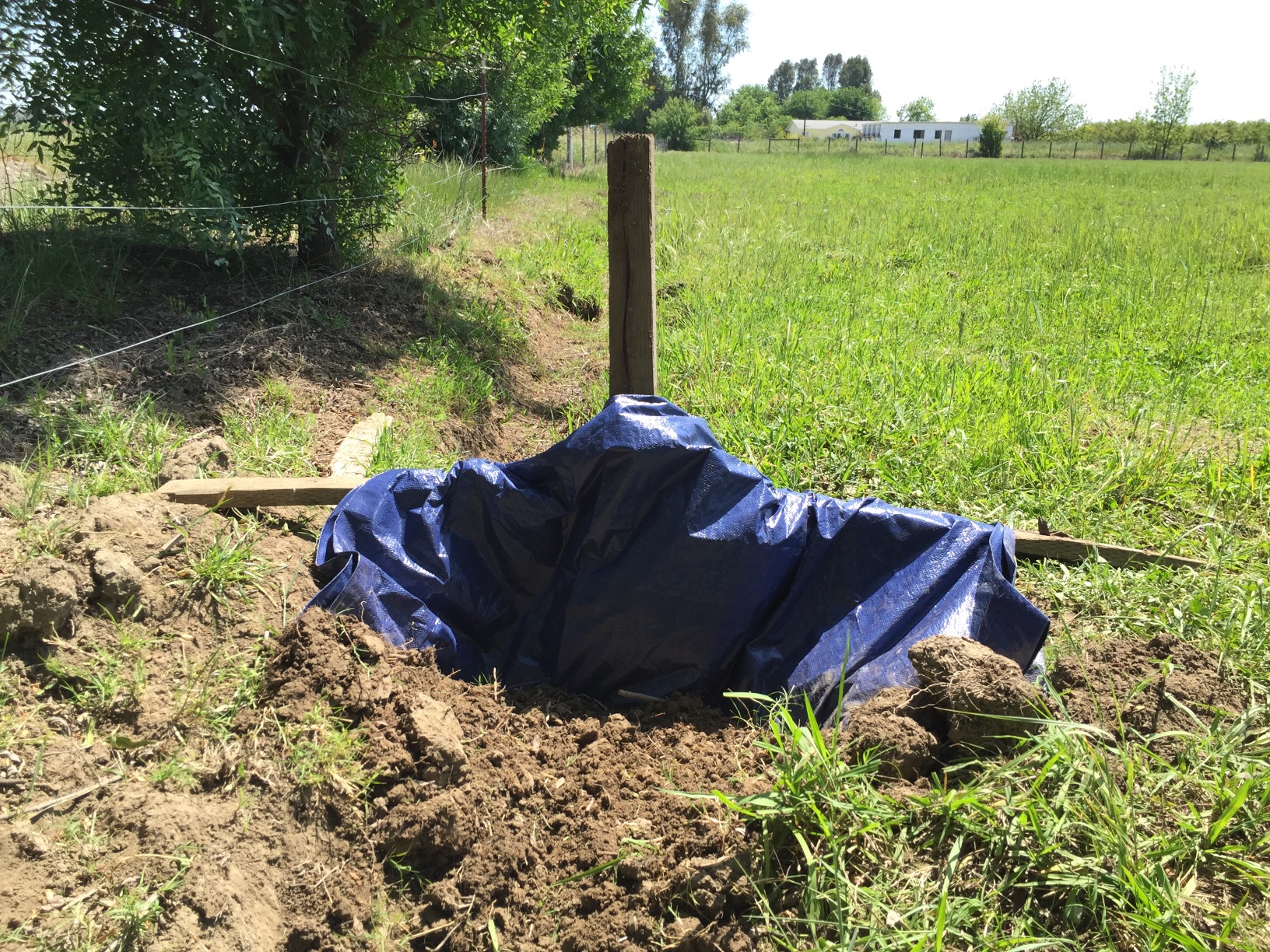 This is a second tarp that I set just around the corner in the ditch that goes south. I shouldn't have to do this, but due to gopher holes, tree roots, and maybe my lack of irrigator skills it seems that one is never enough. Two tarps hold the water back better. Or at least one is a back-up for the other.
This is a second tarp that I set just around the corner in the ditch that goes south. I shouldn't have to do this, but due to gopher holes, tree roots, and maybe my lack of irrigator skills it seems that one is never enough. Two tarps hold the water back better. Or at least one is a back-up for the other.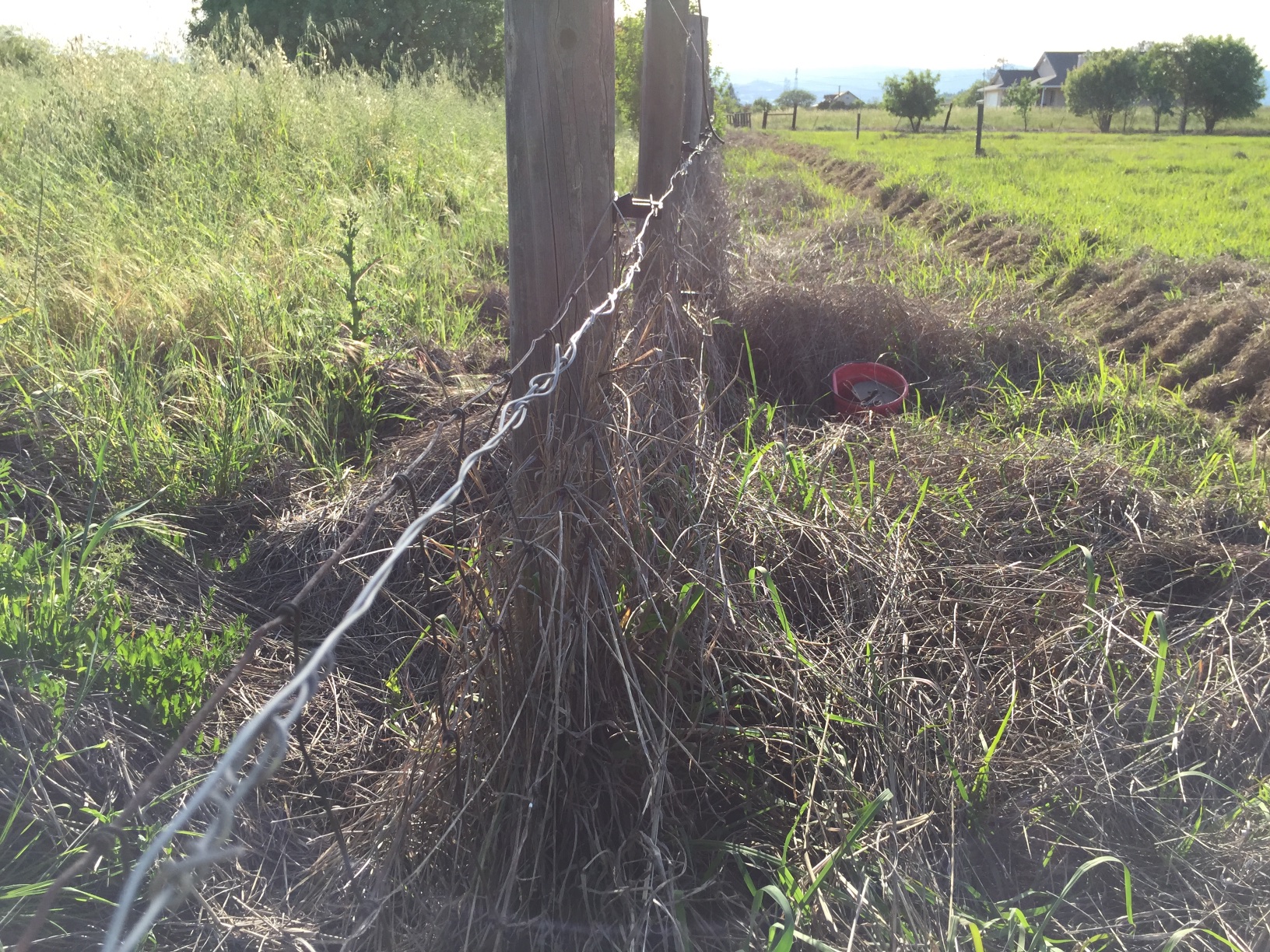 While I was working in the pasture I saw that a couple of lambs had their heads through the electric net fence and didn't seem to care. That prompted a search for the problem with the electric fence. I found a broken wire at the south end. I got new wire and fixed it but then found several more places where I had joined new wire to old. The more times you do that the less conductivity there is. So I took out a long stretch of the old pieced-together wire and replaced it. Low and behold, my tester showed higher strength than it has in years!
While I was working in the pasture I saw that a couple of lambs had their heads through the electric net fence and didn't seem to care. That prompted a search for the problem with the electric fence. I found a broken wire at the south end. I got new wire and fixed it but then found several more places where I had joined new wire to old. The more times you do that the less conductivity there is. So I took out a long stretch of the old pieced-together wire and replaced it. Low and behold, my tester showed higher strength than it has in years!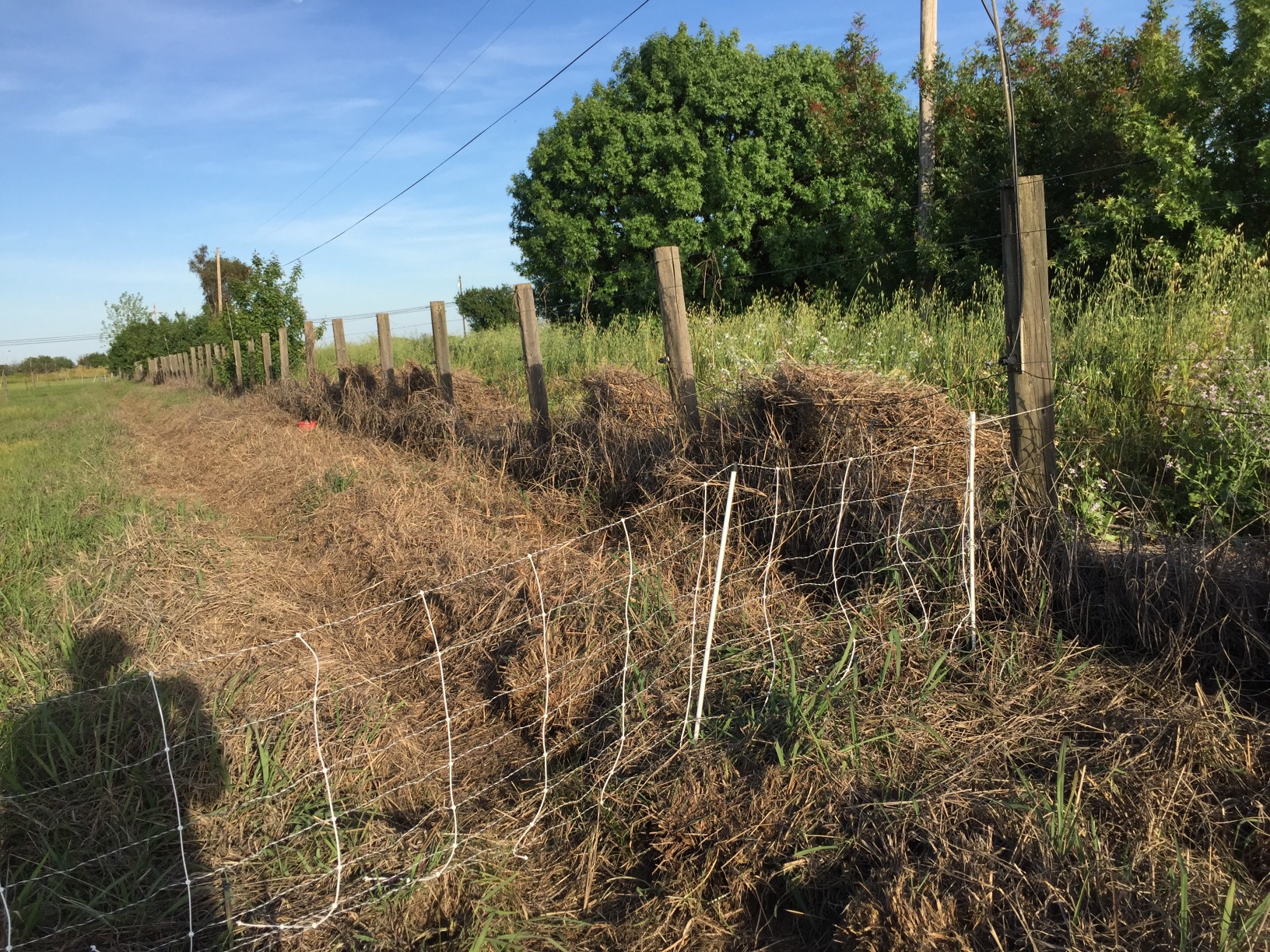 One thing leads to another. While I was at that end of the pasture I was bothered again by the old dallisgrass that effectively mulches my pasture. It's one thing to mulch a garden to keep weeds from growing, but mulching a pasture is counter-productive. If you search dallisgrass in this blog you'll find many attempts to deal with this. This time I was simply knocking it off the electric wire that is about a foot and a half up on inside this fenceline. It broke and pulled away so easily at this time (this is last year's dry grass) that I started pulling it away by the armfuls. I didn't have any tools or even gloves, but threw mounds of it over the fence--hey, I'll mulch the outside of the fence and maybe keep the growth down there. That felt somewhat productive although it may not be useful at all. But at least I could see a difference in the before and after.
One thing leads to another. While I was at that end of the pasture I was bothered again by the old dallisgrass that effectively mulches my pasture. It's one thing to mulch a garden to keep weeds from growing, but mulching a pasture is counter-productive. If you search dallisgrass in this blog you'll find many attempts to deal with this. This time I was simply knocking it off the electric wire that is about a foot and a half up on inside this fenceline. It broke and pulled away so easily at this time (this is last year's dry grass) that I started pulling it away by the armfuls. I didn't have any tools or even gloves, but threw mounds of it over the fence--hey, I'll mulch the outside of the fence and maybe keep the growth down there. That felt somewhat productive although it may not be useful at all. But at least I could see a difference in the before and after.